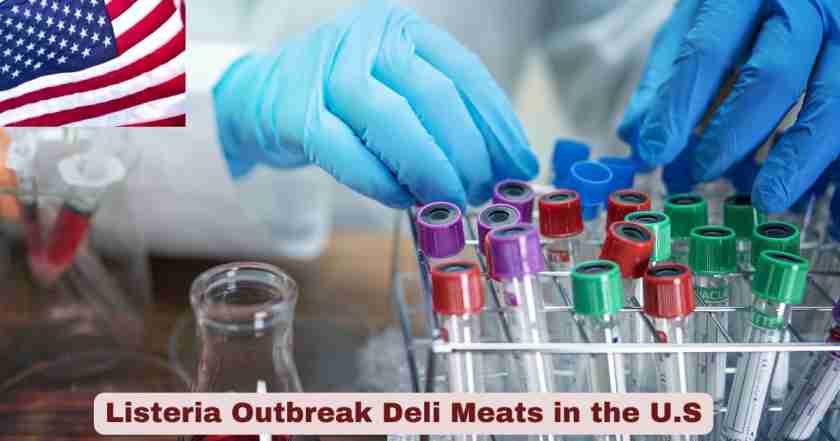Listeria Outbreak Deli Meats in the US 2025
The United States witnessed one of the most severe foodborne illness outbreaks in recent years when a listeria monocytogenes outbreak linked to deli meats emerged across multiple states. This outbreak, which began in May 2024 and extended into early 2025, represents the largest listeriosis outbreak since the devastating cantaloupe outbreak in 2011. The contamination was primarily traced to Boar’s Head brand liverwurst and other deli products manufactured at their Jarratt, Virginia facility, highlighting critical food safety vulnerabilities in the deli meat processing industry.
The outbreak severely impacted vulnerable populations, particularly those aged 65 and older, pregnant women, and individuals with compromised immune systems. With a 98% hospitalization rate among confirmed cases, this outbreak demonstrated the deadly potential of listeria contamination in ready-to-eat foods. The Centers for Disease Control and Prevention officially declared the outbreak over in February 2025, but not before it claimed 10 lives and infected 61 people across 19 states, making it one of the most significant public health emergencies in the food safety sector.
Key Stats & Facts About Listeria Outbreak Deli Meats in the US 2025
| Outbreak Statistic | Data |
|---|---|
| Total Cases | 61 |
| Total Deaths | 10 |
| Hospitalization Rate | 98% (60 out of 61 cases) |
| States Affected | 19 |
| Outbreak Duration | May 2024 – February 2025 |
| Age Range | 32-95 years |
| Median Age | 78 years |
| Primary Source | Boar’s Head Liverwurst |
| Deli Meat Consumption Rate | 94% of interviewed patients |
| Liverwurst Consumption Rate | 61% of interviewed patients |
The statistical data reveals the devastating impact of this outbreak on American public health. The 61 confirmed cases represent only the tip of the iceberg, as health officials estimate the true number of affected individuals was significantly higher due to unreported cases and delayed testing. The 98% hospitalization rate is extraordinarily high, demonstrating the severe nature of listeria infections, particularly among the elderly population who comprised the majority of victims.
The 10 fatalities occurred across multiple states, with South Carolina reporting 2 deaths, while Illinois, New Jersey, New York, Virginia, Florida, Tennessee, and New Mexico each reported 1 death. The median age of 78 years underscores how this outbreak disproportionately affected senior citizens, who are at higher risk for severe listeriosis complications. The fact that 94% of interviewed patients consumed deli meats and 61% specifically consumed liverwurst provided crucial epidemiological evidence linking the outbreak to contaminated deli products, particularly Boar’s Head brand items.
Demographics of Affected Patients in the US 2025
| Demographic Category | Percentage | Details |
|---|---|---|
| Gender Distribution | 51% Male, 49% Female | Nearly equal gender distribution |
| Racial Composition | 78% White, 16% African American/Black, 3% Asian, 3% Other | Predominantly affected White population |
| Ethnicity | 94% Non-Hispanic, 6% Hispanic | Overwhelmingly Non-Hispanic victims |
| Age Range | 32-95 years | Wide age spectrum affected |
| Median Age | 78 years | Elderly population most vulnerable |
| Pregnancy Cases | 1 woman | Remained pregnant after recovery |
The demographic analysis reveals critical patterns in the outbreak’s impact across different population groups. The near-equal gender distribution suggests that biological sex did not significantly influence susceptibility to this particular listeria strain. However, the predominant impact on White populations (78%) and non-Hispanic individuals (94%) may reflect consumption patterns of deli meats or access to specific retail outlets where contaminated products were sold.
The age demographics are particularly concerning, with the median age of 78 years highlighting the extreme vulnerability of elderly populations to severe listeriosis. The wide age range from 32 to 95 years demonstrates that while older adults were most severely affected, the contamination posed risks across adult age groups. The single pregnancy case that resulted in recovery is notable, as listeria typically poses severe risks to pregnant women and their unborn children, often leading to miscarriage, stillbirth, or severe newborn infections.
Geographic Distribution of Listeria Cases in the US 2025
| Region | States Affected | Notable Death Locations |
|---|---|---|
| Northeast | New Jersey, New York | New Jersey (1 death), New York (2 deaths) |
| Southeast | Florida, South Carolina, Virginia, Tennessee | Florida (1 death), South Carolina (2 deaths), Tennessee (1 death), Virginia (1 death) |
| Midwest | Illinois | Illinois (1 death) |
| Southwest | New Mexico | New Mexico (1 death) |
| Total States | 19 states | 10 deaths across 8 states |
The geographic spread of this outbreak demonstrates the extensive distribution network of contaminated deli products and the interconnected nature of the US food supply chain. The concentration of cases in the Northeast and Southeast regions suggests these areas had higher consumption rates of Boar’s Head products or greater exposure to contaminated deli meats from the Virginia manufacturing facility.
The multi-state nature of this outbreak, spanning 19 states, illustrates how a single contaminated food processing facility can impact public health on a national scale. The Southeast region bore the heaviest burden with 5 deaths across four states, possibly due to regional distribution patterns or higher consumption rates of the specific contaminated products. The fact that deaths occurred in 8 different states underscores the widespread distribution of contaminated products and the challenges faced by public health officials in containing such outbreaks.
Timeline and Progression of Cases in the US 2025
| Time Period | Cases Reported | Deaths | Key Milestones |
|---|---|---|---|
| May 29, 2024 | First sample collected | 0 | Outbreak begins |
| July 19, 2024 | 28 cases | 2 deaths | Initial CDC alert issued |
| July 26, 2024 | 34 cases | 2 deaths | Boar’s Head recall initiated |
| August 8, 2024 | 43 cases | 3 deaths | Expanded investigation |
| August 28, 2024 | 57 cases | 9 deaths | Major recall expansion |
| September 13, 2024 | 59 cases | 10 deaths | Last illness onset |
| February 27, 2025 | 61 cases | 10 deaths | Outbreak declared over |
The timeline reveals a rapidly escalating public health crisis that took months to fully contain. The period between July and August 2024 saw the most dramatic increase in cases, jumping from 28 to 57 cases within just one month. This exponential growth pattern is typical of foodborne outbreaks where contaminated products remain in circulation.
The three-month gap between the last illness onset in September 2024 and the official closure declaration in February 2025 demonstrates the cautious approach taken by health officials to ensure no additional cases emerged. The rapid increase in death toll from 2 to 9 fatalities between July and August highlights the deadly progression of severe listeriosis cases, particularly among vulnerable elderly patients who comprised the majority of victims.
Food Consumption Patterns in the US 2025
| Food Item | Consumption Rate | Specific Brand |
|---|---|---|
| Any Deli Meats | 94% of interviewed patients | Various brands |
| Deli-Sliced Meats | 96% of deli meat consumers | Various retailers |
| Liverwurst | 61% of interviewed patients | Predominantly Boar’s Head |
| Boar’s Head Liverwurst | 20 patients specifically | Confirmed brand consumption |
| Various Deli Locations | Multiple supermarkets | Widespread distribution |
The consumption pattern analysis provided crucial epidemiological evidence linking the outbreak to specific food products. The extraordinarily high 94% consumption rate of deli meats among interviewed patients far exceeded normal population consumption patterns, providing strong statistical evidence of causation. The 96% rate of consumption of specifically deli-sliced meats further narrowed the investigation focus.
The 61% liverwurst consumption rate among patients was particularly significant, as liverwurst consumption in the general population is relatively low, making this finding statistically remarkable. The identification of 20 patients who specifically consumed Boar’s Head brand liverwurst provided the smoking gun evidence that led to the massive product recalls and facility shutdown. This consumption data was instrumental in the CDC’s case-control analysis that definitively linked the outbreak to contaminated deli products.
Recall and Public Health Response in the US 2025
| Response Action | Date | Scope |
|---|---|---|
| Initial Boar’s Head Recall | July 26, 2024 | Liverwurst products |
| Expanded Recall | July 30, 2024 | Additional deli products |
| Full Facility Recall | August 2024 | All products from Jarratt, VA facility |
| Facility Shutdown | August 2024 | Temporary closure for remediation |
| Outbreak Declared Over | February 27, 2025 | Complete investigation closure |
The public health response escalated rapidly as the severity of the outbreak became apparent. The initial recall on July 26 was limited to liverwurst products, but within just four days, Boar’s Head expanded the recall to include additional deli products as investigators uncovered broader contamination issues. The ultimate decision to recall all products from the Jarratt, Virginia facility represented one of the most comprehensive food recalls in recent years.
The facility shutdown was a critical intervention that likely prevented hundreds of additional cases by removing the contamination source from the market. The six-month gap between the last illness onset and the outbreak closure declaration reflects the thorough investigation process and the time required to ensure no additional cases would emerge. This comprehensive response, while costly to the company, demonstrated the effectiveness of coordinated federal and state public health agencies in managing large-scale foodborne illness outbreaks.
Prevention and Safety Measures in the US 2025
| Risk Group | Recommendation | Temperature Requirement |
|---|---|---|
| Pregnant Women | Avoid deli meats or heat before consumption | 165°F or steaming hot |
| Adults 65+ | Avoid deli meats or heat before consumption | 165°F or steaming hot |
| Immunocompromised | Avoid deli meats or heat before consumption | 165°F or steaming hot |
| General Population | Check for recalls, clean refrigerators | 165°F for reheating |
| Food Businesses | Follow USDA-FSIS best practices | Proper temperature controls |
The outbreak led to enhanced safety recommendations that remain in effect even after the outbreak’s conclusion. The specific 165°F temperature requirement for reheating deli meats is based on research showing that this temperature effectively kills listeria bacteria. The emphasis on high-risk populations avoiding deli meats entirely reflects the disproportionate impact on vulnerable individuals observed during this outbreak.
The recommendation for refrigerator cleaning addresses listeria’s unique ability to grow at refrigeration temperatures, unlike many other foodborne pathogens. For food businesses, the outbreak reinforced the critical importance of following USDA-FSIS best practices for controlling listeria contamination in deli environments, including proper cleaning protocols, temperature monitoring, and cross-contamination prevention measures. These prevention strategies represent lessons learned from one of the deadliest listeria outbreaks in recent US history.
Laboratory and Genetic Analysis in the US 2025
| Analysis Type | Results | Significance |
|---|---|---|
| Whole Genome Sequencing | Identical bacterial strains | Confirmed single outbreak source |
| Product Testing | Positive listeria in Boar’s Head products | Direct contamination evidence |
| Strain Matching | Patient and product strains identical | Definitive source confirmation |
| Multi-State Coordination | 19 states collaborated | Comprehensive outbreak mapping |
| Laboratory Confirmation | Maryland and New York labs | Independent verification |
The laboratory analysis provided definitive scientific evidence linking patient illnesses to contaminated products. Whole Genome Sequencing (WGS) technology was crucial in confirming that all 61 cases were caused by the same bacterial strain, ruling out multiple independent outbreaks. The positive listeria identification in unopened Boar’s Head products from retail stores provided direct evidence of contamination in the distribution chain.
The strain matching between patient samples and product samples represented the gold standard of outbreak investigation, providing irrefutable proof of causation. The collaboration between Maryland and New York laboratories with independent confirmatory testing strengthened the scientific validity of the findings. This sophisticated laboratory work, coordinated across 19 states, demonstrated the advanced capabilities of the US public health surveillance system in rapidly identifying and characterizing foodborne disease outbreaks.
Economic and Industry Impact in the US 2025
| Impact Category | Effect | Scale |
|---|---|---|
| Product Recalls | Complete facility production | Millions of pounds |
| Facility Closure | Temporary shutdown | Months of production loss |
| Legal Liability | Wrongful death lawsuits | Hundreds of millions potential |
| Industry Standards | Enhanced safety protocols | Industry-wide changes |
| Consumer Confidence | Decreased deli meat sales | Market-wide impact |
The economic ramifications of this outbreak extended far beyond the immediate health impacts. The complete recall of products from the Jarratt facility involved millions of pounds of deli meat products, representing unprecedented financial losses for Boar’s Head. The facility closure disrupted production for months, affecting not only the company but also retailers and consumers nationwide.
The legal liability associated with 10 deaths and 61 severe illnesses likely amounts to hundreds of millions of dollars in settlements and legal costs. The outbreak prompted industry-wide changes in safety protocols, food testing procedures, and facility monitoring systems. The impact on consumer confidence in deli meats extended beyond Boar’s Head products, affecting the entire ready-to-eat meat industry and highlighting the interconnected nature of food safety and economic stability in the modern food system.
Disclaimer: The data research report we present here is based on information found from various sources. We are not liable for any financial loss, errors, or damages of any kind that may result from the use of the information herein. We acknowledge that though we try to report accurately, we cannot verify the absolute facts of everything that has been represented.







